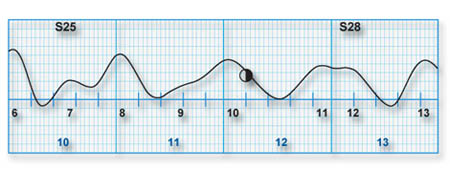
On the numbers assigned to the tidal waves.
============================================================
In this site, in order to understand the phenomena more readily, the tidal waves of semi-diurnal basins are numbered, following the order of their arrival unto the coast. On the graph, from the left to the right.
On average, in a semi-diurnal basin, there are roughly two tidal waves per day. However, because of the combined effect of the declination of the Moon and Sun, almost all the tidal waves come as a group of two, where the first one is late (relative to the time being the Moon declination zero), the second one is early.
The intervals in a series of tidal waves.
The intervals in a series of successive tidal waves are, consequently, almost never equal and regular. A short interval between two tide waves, comes after a long interval between two tide waves. Thus forming groups of two waves each, with short intervals between them.
To the tidal waves of a group of two, an odd number is attributed to the one which comes first. While an even number is attributed to the wave which comes second.

A group of two waves gets formed when one is late, and the succesive one is early. In a group of two tide waves, it is the even number one which is early, and comes near to the preceding wave, the one with an odd number. This way a short interval between the two waves is formed.
Let's visualise the tidal waves as trains.
Let's visualise a group of two tidal waves, as they were trains. In a circle railway line, there are two trains each day, always bound in the same direction, and every day, departing later and later.
On the first day considered, the first train should depart at just before noon, the second one just after midnight. Instead, the first train (the noon train, an odd number train) in reality departs late at 2 o'clock p.m.; the second train (the midnight train, an even number train) departs early at 10 o'clock p.m.
Thus, the interval between the two trains is less than twelve hours.
Almost the same occurs the following day. The odd number train departs at 2:40 p.m. The interval between this one and the preceding even number train, already considered, is more than twelve hours.
The single wave.
Reverting to our subject, around every 14-15 days, it depends, there is a tidal wave that is between two intervals which are almost equal. That wave has also another feature: its height is well pronounced, if compared with those nearby. To this single wave the zero number is attributed.
The tidal wave which follows a 1 wave, is the wave number “1” of a new series.
The two waves get near.
Due to bottlenecks, above all in places such as in the lagoon of Venice, an even number wave tends to get near the preceding odd number wave.
In this case, the interval between an odd number wave and an even number one may become very short. The two waves may even get fused.
============================================================
index tides ||| © copyright notice